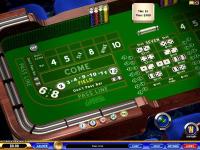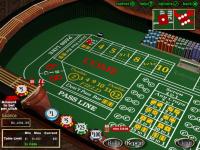Craps Game Rules
 |
|
|||||||||||||||||||||||||||||||||||||||||||||||
|
Game rules for Craps:The basicsCraps is one of the most exciting casino games. It is common to hear yelling and shouting at a craps table. It is played on a purpose-built table and two dice are used. The dice are made after very strict standards and are routinely inspected for any damage. As a matter of course, the dice are replaced with new ones after about eight hours of use, and casinos have implemented rules in the way a player handles them.The player must handle the dice with one hand only when throwing and the dice must hit the walls on the opposite end of the table. In the event that one or both dice are thrown off the table, they must be inspected (usually by the stickman) before putting them back into play. The craps table can accommodate up to about 20 players, who each get a round of throws or at 'shooting' the dice. If you don't want to throw the dice, you can bet on the thrower. Several types of bets can be made on the table action. The casino crew consist of a stickman, boxman and two dealers. The first roll of the dice in a betting round is called the Come Out roll - a new game in Craps begins with the Come Out roll. A Come Out roll can be made only when the previous shooter fails to make a winning roll, that is, fails to make the Point or seven out. A new game then begins with a new shooter. If the current shooter does make his Point, the dice are returned to him and he then begins the new Come Out roll. This is a continuation of that shooter's roll, although technically, the Come Out roll identifies a new game about to begin. When the shooter fails to make his or her Point, the dice are then offered to the next player for a new Come Out roll and the game continues in the same manner. The new shooter will be the person directly next to the left of the previous shooter - so the game moves in a clockwise fashion around the craps table. The dice are rolled across the craps table layout. The layout is divided into three areas - two side areas separated by a center one. Each side area is the mirror reflection of the other and contains the following: Pass and Don't Pass line bets, Come and Don't Come bets, Odds bet, Place bets and Field bets. The center area is shared by both side areas and contains the Proposition bets. Pass bets win when the come out roll is 7 or 11, while pass bets lose when the come out roll is 2, 3, or 12. Don't bets lose when the come out roll is 7 or 11, and don't bets win when the come out roll is 2 or 3. Don't bets tie when the come out roll is 12 (2 in some casinos; the 'Bar' roll on the layout indicates which roll is treated as a tie). Below is a list of the various bets you can make at craps. Pass Line Bet - You win if the first roll is a natural (7, 11) and lose if it is craps (2, 3, 12). If a point is rolled (4, 5, 6, 8, 9, 10) it must be repeated before a 7 is thrown in order to win. If 7 is rolled before the point you lose. Odds on Pass Line Bet - After a point is rolled you can make this additional bet by taking odds. There are different payoffs for each point. A point of 4 or 10 will pay you 2:1; 5 or 9 pays 3:2; 6 or 8 pays 6:5. You only win if the point is rolled again before a 7. Come Bet - It has the same rules as the Pass Line bet. The difference consists in the fact you can make this bet only after the point on the pass line has been determined. After you place your bet the first dice roll will set the come point. You win if it is a natural (7, 11) and lose if it is craps (2, 3, 12). Other rolls will make you a winner if the come point is repeated before a 7 is rolled. If a 7 is rolled first you lose. Odds on Come Bet - Exactly the same thing as the Odds on Pass Line bet except you take odds on the Come bet not the Pass Line bet. Don't Pass Line Bet - This is the reversed Pass Line bet. If the first roll of a dice is a natural (7, 11) you lose and if it is a 2 or a 3 you win. A dice roll of 12 means you have a tie or push with the casino. If the roll is a point (4, 5, 6, 8, 9, 10) a 7 must come out before that point is repeated to make you a winner. If the point is rolled again before the 7 you lose. Don't Come Bet - The reversed Come Bet. After the come point has been established you win if it is a 2 or 3 and lose for 7 or 11. 12 is a tie and other dice rolls will make you win only if a 7 appears before them on the following throws. Place Bets - This bet works only after the point has been determined. You can bet on a dice roll of 4, 5, 6, 8, 9 and 10. You win if the number you placed your bet on is rolled before a 7. Otherwise you lose. The Place Bets payoffs are different depending on the number you bet on. 4 or 10 will pay 9:5; 5 or 9 pays 7:5, and 6 or 8 pays 7:6. You can cancel this bet anytime you want to. Field Bets - These bets are for one dice roll only. If a 2, 3, 4, 9, 10, 11, 12 is rolled you win. A 5, 6, 7 and 8 make you lose. Field Bets have the following different payoffs: 2 pays double (2:1) while 12 pays 3:1. Other winning dice rolls pays even (1:1). Big Six, Big Eight Bets - Placed at any roll of dice these bets win if a 6 or 8 comes out before a 7 is rolled. Big Six and Big Eight are even bets and are paid at 1:1. Proposition Bets - These bets can be made at any time and, except for the hardways, they are all one roll bets:
|
|||||||||||||||||||||||||||||||||||||||||||||||
| ||||||||||||||||||||||||||||||||||||||||||||||||





